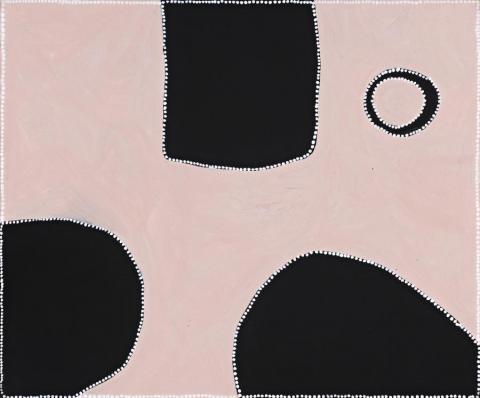MENDOOWOORRJI - MEDICINE POCKET, 2001
PADDY BEDFORD
natural earth pigments and synthetic binder on linen
150.0 x 180.0 cm
inscribed verso: title, Jirrawun Arts cat. PB32001-105
Jirrawun Arts, Kununurra
Grantpirrie, Sydney
Private collection, Adelaide
Private collection, Melbourne
This painting is accompanied by a certificate from Grantpirrie, Sydney
Storer, R., Paddy Bedford, Museum of Contemporary Art, Sydney, 2006, p. 150 (illus.)
For another painting of Mendoowoorrji - Medicine Pocket, held in the Laverty Collection see: Beyond Sacred; Recent Paintings from Australia's Remote Aboriginal Communities, The collection of Colin and Liz Laverty, Hardie Grant Books, Prahran, 2008, p. 233
Paddy Bedford was a Gija elder from Warmun in the north east Kimberley region of Western Australia. As a senior law man he has been involved in painting as part of ceremony all his life. He began painting on canvas for exhibition, after Freddie Timms set up the Jirrawun Aboriginal Art group at Rugun (Crocodile Hole) in 1997 and is represented in several major collections including the Art Gallery of NSW and the National Gallery of Australia.
Painted in 2001, this work is catalogued as painting 105 in Bedford's chronological index of works. Depicting the country of Mendoowoorrji- Medicine Pocket, located south east of Bedford Downs. Mendoowoorrji is the general name given to the line of hills running between Thoonbi the Ord river and Thoowoonggoonarrin Tunganary Gorge. The site is characterised by creeks and watercourses running in open land with rocky outcrops flanked by a line of hills. This place is also associated with the dreaming place of the crow, Wanggarnal, who camped here when she was a woman in the dreamtime. The area was an important camping area for local people before the arrival of Europeans. It is associated with Bedford's familal custodial knowledge being part of his mother's dreaming, where two men hit each other with sticks and became part of the country.
Stylistically, Mendoowoorrji carries further the manner and sparseness that exemplified the east Kimberley school. Sharing a similar sensibility to Rover Thomas and Freddie Timms, Bedford's work is distinguished by a limited use of palette and bold abstract forms contained in a defined structure that is articulated by an outline of minimal dotting. In this work, his use of colours has moved on from the natural ochres of his first paintings to incorporate softer, more delicate hues of pink contrasted against the black forms with white outline dotting.
In 2006 Paddy Bedford was honoured with a major retrospective at the Museum of Contemporary Art, Sydney and he was also one of eight Aboriginal artists commissioned to provide work for the new Musée du quai Branly in Paris. As Tony Oliver observes, 'The magic of Paddy's paintings is that the narratives extend beyond the literal, beyond the single allegory. Yes there is always a story, but more importantly there is also a non-verbal story that is more like music and poetry'.1
1. Oliver, T., 'Paddy Bedford From Crocodile Hole and Kununurra', in Beyond Sacred; Recent Paintings from Australia's remote Aboriginal Communities, The collection of Colin and Liz Laverty, Hardie Grant Books, Prahran, 2008, p. 225
